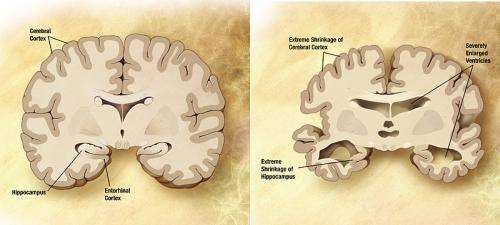Different 'subtypes' of Alzheimer's may be linked to different modifications of the tau protein

A new study reveals a possible biological reason that Alzheimer's Disease (AD) progresses at different rates in different patients.
The study, which was led by Massachusetts General Hospital researchers, focused on tau, a protein found in the neurofibrillary tangles in the brain that are a well-known sign of AD.
Tau can undergo a variety of modifications during the course of the disease including phosphorylations. Researchers found that the presence of different forms of phosphorylated tau could explain why the disease has variable effects.
The study's lead author is Simon Dujardin, PhD, post-doctoral research fellow at Mass Gemeral. It was published in Nature Medicine.
Physicians have long known that, from patient to patient, there can be substantial variation in the clinical presentation of Alzheimer's Disease, including age of onset, rate of memory decline and other clinical measures.
Also, higher levels of pathological tau in the brain are associated with more severe disease. However, there are few clues as to what causes this variation between patients.
This team studied samples from 32 patients who were diagnosed with what is considered "typical AD" while living, and that diagnosis was confirmed after death.
The age at diagnosis and the rate of disease progression varied markedly among these patients.
More Details About the Study
The researchers also conducted an in-depth characterization of the molecular features of tau proteins within the brains of these patients.
This included levels of different species of tau, capacity of tau to induce aggregation (also called seeding), as well as the presence of specific post-translational modifications using biochemical, biophysical and bioactivity assays, as well as advanced mass spectrometry techniques, working with teams at Children's Hospital, Boston and Merck.
The researchers found "striking" variation in the presence of phosphorylated tau oligomers that associates with greater tau spread, and, importantly, worse disease.
Different specific modifications were associated with different degrees of severity and progression rate.
Notably, these specific molecular characteristics led to variable recognition by antibodies which are currently being considered for the therapeutic targeting of tau proteins in AD and associated diseases.
"We speculate that there are different molecular 'drivers' of Alzheimer's progression, with each patient having their own set of these," says Bradley Hyman, MD, Ph.D., senior author of the report and director of the Alzheimer's Disease Research Center at the Massachusetts General Institute for Neurodegenerative Disease (MIND). Hyman adds that,
"This is similar to what we see in cancer, where there are several types of lung or breast cancer, for example, and the treatment depends on the particular molecular drivers in the patient's tumor."
More information: Simon Dujardin et al, Tau molecular diversity contributes to clinical heterogeneity in Alzheimer's disease, Nature Medicine (2020). DOI: 10.1038/s41591-020-0938-9





















